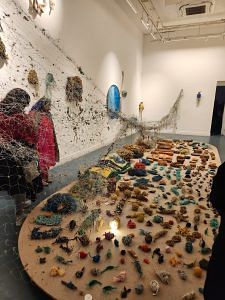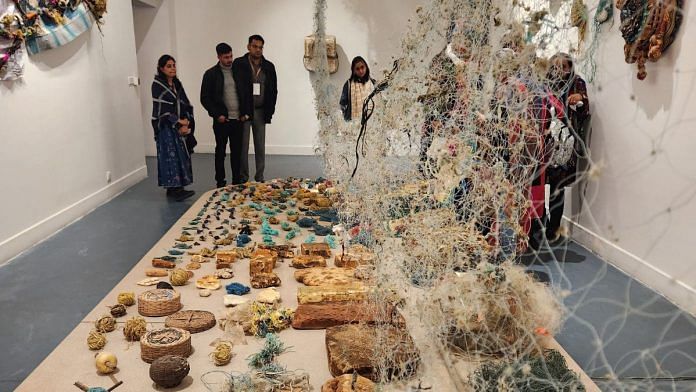New Delhi: Art installations, artworks and galleries use environmentally unsustainable materials too often. It is rare, but when artists make the effort to stir this use-and-throw culture’s conscience, it stands out.
What do the oceans return to us? Mostly our trash. This simple truth is both the medium and the message at the Sustaina India art exhibition, which opened in New Delhi on 2 February and will continue till 15 February at the CCA gallery in Bikaner House. A set of new installations at the two-week show forces the viewer to also receive what they throw. After all, the ocean holds the secrets of our odious conspicuous consumption.
A used fishing net spreads its embrace across the installation in a white cube art space; materials made out of beach waste strewn on the floor, insect sculptures on the wall and jute bags made out of discarded packages. And a dramatic artwork is ready. The medium is the message.
Artist and environmentalist Rachna Toshniwal’s giant installation, titled ‘There is No Such Thing Called Waste’, is part of an art fellowship set up by artists Thukral and Tagra in collaboration with the Council on Energy, Environment and Water (CEEW) – a climate think tank that tries to embed the sustainability message in a three-dimensional space that viewers can engage with.
Reduce, reuse, repurpose, restore
The world of art and environmental consciousness have similar advocates but they remain in separate bubbles. Toshniwal’s past as an environmental activist informs her art today.

She spent over four months collecting different materials retrieved from the sea – ropes, nets, wood, plastic, jute and coir – in collaboration with the Naari Shakti women’s self-help group in Alibaug, Maharashtra. A walk in the forest and on the beach is usually how she collects material – twigs, roots, strings, shells, as well as litter. Out of these, she has created dozens of art objects, tapestries and sculptures, displaying them as an interlocked inextricable crowdedness. She even avoided using glue because she didn’t want to introduce a new chemical to the process.
“What is waste? I am trying to change the gaze. Without that shift in perception, we can’t change our behaviour,” said Toshiniwal. “I want to start looking at our lived environment in a different way, what we are consuming, what we are calling litter. In nature, everything is circular. They come back. But we have created materials that are not in that circular loop.”
At every juncture of the exhibition, read the brochure, CEEW “returned to the ideas of reducing, reusing, repurposing and restoring.”
Its larger message is one of the health of the oceans and the role of human beings in ruining it. The material and the artwork are so unabashedly stark in implicating unsustainable cultures that it is literally a ‘hand in the cookie jar’ moment for the viewer. The waste that washes up on Saaral Beach has their fingerprints all over it.
“I have decided that I only want to work with found material in my art from now on,” said Toshiniwal. “They have a different life story, form, and they elicit a very different response too.”
(Edited by Zoya Bhatti)



